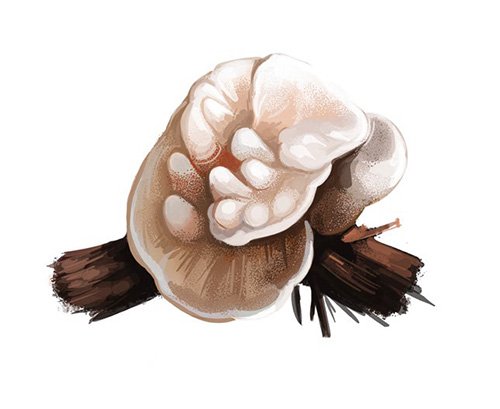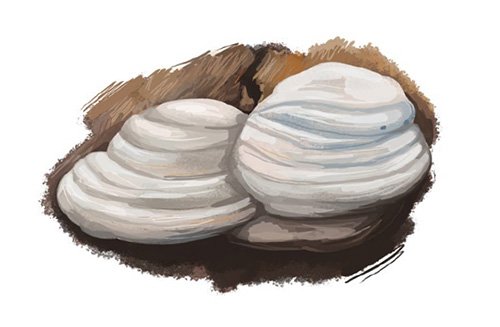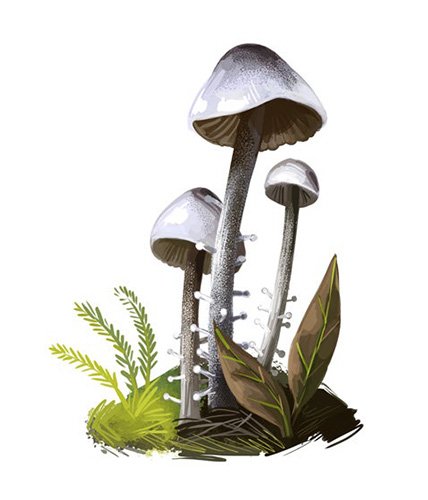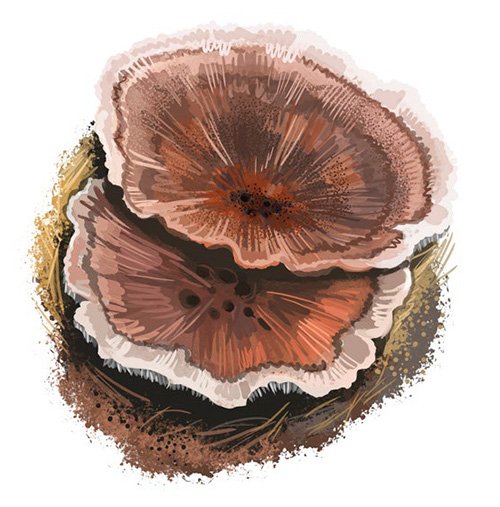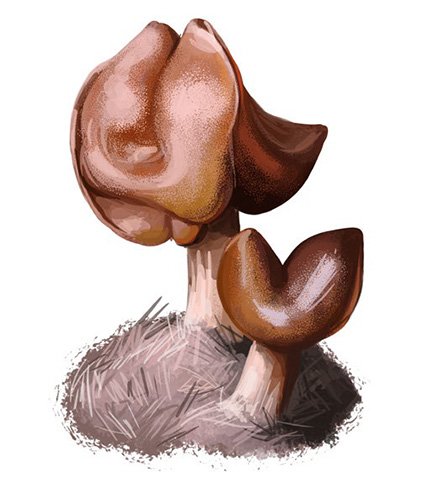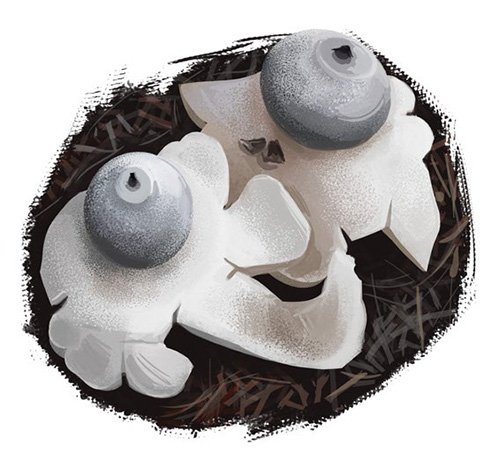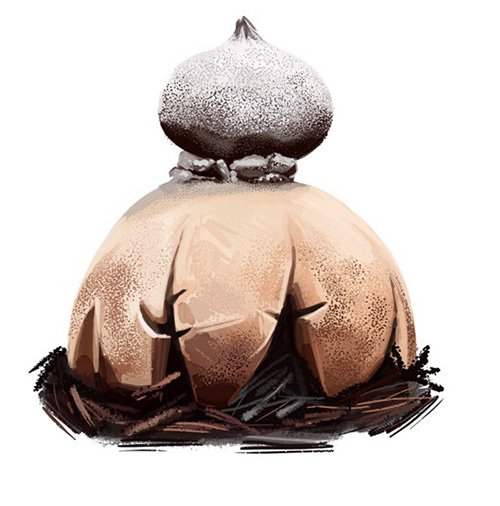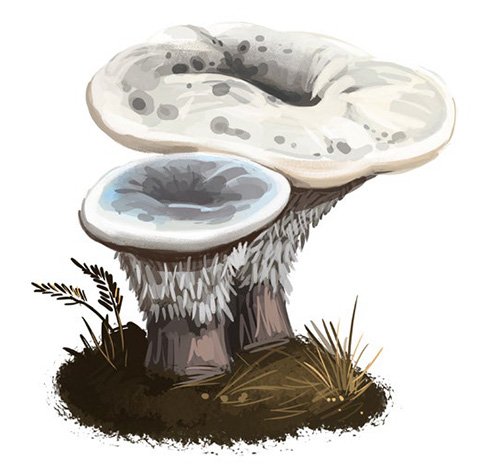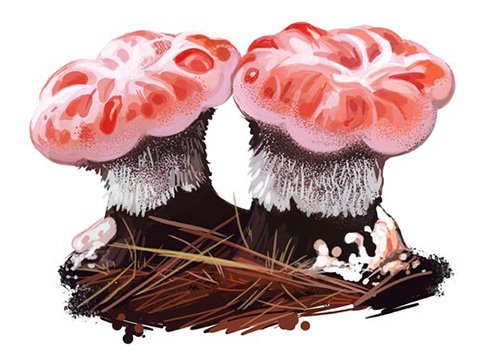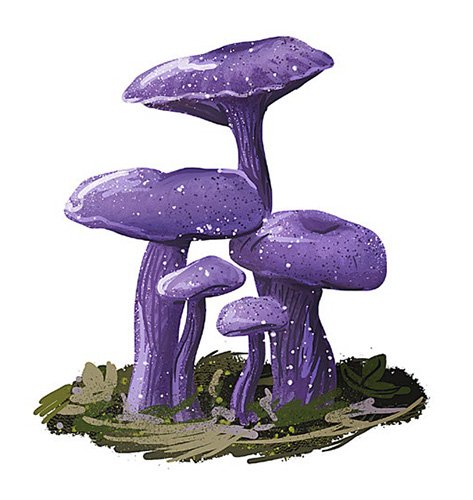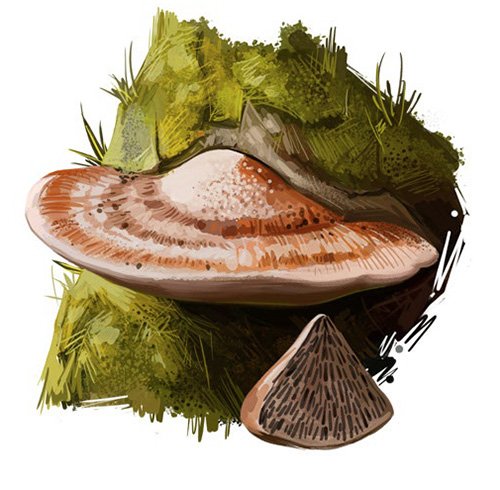The Fungus Among Us
Though humans aren’t related to fungi as evolutionists claim, we are more connected than you might imagine.
As a little girl watching our landlord mow the lawn, I spotted a cloud of dust erupting every now and then beneath the mower. One day I discovered golf ball-size white pillows in the grass. When I nudged one, the ball exploded with a satisfying little poof.
A few years ago in a cemetery, I spotted another puffball and eagerly pressed my toe against it. I grinned as it spewed a cloud of dust. Of course, that dust was actually spores, the fungi version of seeds. Rather than the usual impetus provided by raindrops or animals, my curiosity had set off this mushroom (Lycoperdon), spreading its chances of growing elsewhere.
Lately I’ve noticed mushrooms popping up everywhere. On sweaters and dishtowels, phone cases and socks, nightlights and mugs, and a pack of 60 stickers that somehow ended up in my online shopping cart. Among the blooming number of mushroom-based products are coffee, jerky, leather, pest control, insulation, and packaging. Science also is turning to mushrooms to treat cancer, lower cholesterol, and regulate blood sugar.
I used to think of mushrooms as the gray chunks in soup or the limp taupe morsels I flicked off pizza. But not too long ago, I watched two documentaries whimsically titled Fantastic Fungi and The Magic of Mushrooms. They featured mushroom experts (mycologists) cooing at the forest floor as they pointed out an array of mushrooms and other fungi species. The varieties enchanted me. Some looked lacy, wavy, shaggy, or pillowy. Some looked as if they had been snipped from paper. Some glowed in the dark. Some were yellow, brown, purple, and—my favorite—red with white spots. Mushrooms, it seemed, were growing on me.
With a fancifal soundtrack playing in the background, the narrator of The Magic of Mushrooms claimed that we are “more mushroom than you could ever imagine.” According to the evolutionary myth, 1 billion to 1.5 billion years ago, the branches that would become animals and plants split on the evolutionary tree. Not for another roughly 10 million years would fungi diverge from the animal branch, creating their own kingdom. This 10-million-year lag means fungi evolved closer to animals than to plants, which means, in evolutionary lingo, closer to humans. But are we related to the same mildew that coats our shower curtain and the toadstools that turn up after a rain?
In stark contrast to this far-fetched fungal tale, Genesis reveals a different memoir for the mushroom, an account in which fungi and humans are not related but are connected in a grand internet of life.
Last but Not Yeast
Even if you miss the mushroom aisle, you might still be filling your grocery cart with fungi.
Breads like hamburger buns, donuts, cookies, crackers, and breaded fried foods almost all contain the fungi yeast. Products such as soy sauce, miso, cider, kimchi, olives, and pickles get their tang from the fermenting process using yeast. Some breakfast cereal contains malt, a fermented barley. And that chocolate bar? After harvest, cocoa beans ferment before being dried and ground into cocoa powder.
But wait—there’s mold. Salami is often covered in a harmless white mold dust. And of course, there’s that vein running through a wedge of blue cheese.
When you start checking labels, you’ll find many products contain citric acid, a preservative derived from fungi. Sour candy, soda, some ice cream, canned foods, caramels, powdered drinks, antacids, and countless other foods stay fresh thanks to citric acid.
The Facts about Fungi
Mycologists estimate that fungi come in up to 3.8 million species, though only 120,000 species have been named and only 20,000 produce the reproductive structures we call mushrooms. The mold in your washing machine, mildew on your shower curtain, your teenager’s itchy athlete’s foot, the yeast in your bread, vein in your blue cheese—you might as well surrender: you’re surrounded by fungi. They live in the air, water, ground, animals, and even you.
But what are fungi exactly? No one would blame you for mistaking them as plants—after all, they often grow from the ground, close to trees and vegetation. But fungi are a kingdom apart from plants and anything else in creation. They are eukaryotes, organisms whose cells have a nucleus housing their DNA. Other eukaryotes include mammals, insects, plants, and humans. Unlike plants, however, fungi don’t have chlorophyll, so they cannot make their own food through photosynthesis. Just as you must eat a burger or broccoli to stay strong, fungi absorb nutrients from other resources, sometimes including burgers and broccoli, though their palate isn’t typically that refined. But more on their menu later.
Fungi also aren’t animals. Though they do some wild things, they don’t have a brain or intelligence. Much like plants, they operate through programming given by the Creator.
A Few Fantastic Fungi
Three Main Types of Fungi
Parasitic
Parasitic fungi feed on a living host, usually plants, eventually leading to the host’s death.
Saprophytic
Saprophytic fungi live on dead organic matter. They play a key role in allowing nutrients from the dead to become accessible to the living. Most cultivated mushrooms (such as oyster mushrooms and button mushrooms) are saprophytic. Some fungi can be both parasitic and saprophytic.
Mycorrhizal
Mycorrhizal fungi have a symbiotic relationship with plant roots. The fungi attach to the roots and supply the water and nutrients the plant needs. In return, the mycorrhizal fungi consume sugars and compounds from plant roots. Some plants cannot live without these fungi.
Three Square Miles
The area covered by a honey mushroom—the world’s largest living organism—in the Blue Mountains of Oregon.
1969
Ecologist Robert Whittaker proposed dividing fungi into its own kingdom, separate from plants.
Mushrooming into Existence
No verse in Genesis proclaims, “And on the fifth day, God created fungi.” But we can deduce from the other aspects of creation which day fungi might have arrived on the scene. We know God made fungi sometime between days three and six. Some fungi that rely on plants might have been created on day three, while others associated with animals might have been created on days five and six. Or all might have been created on day three since traditional Hebrew includes fungi and bacteria in the plant kingdom. Whichever day they were created, we can be sure God spoke all the original fungi kinds into existence, no millions of years involved.
One Big Fungal Family
- 90% of the estimated 2–3.8 million fungi species are unknown.
- 200+ species of fungi are likely hallucinogenic.
- 80+ species of mushrooms glow in the dark.
- 3% of mushroom species are poisonous. Only a few are fatal.
You might have heard the claim that humans and fungi share up to half their DNA. That sounds like a fungal falsity you’d flat out refuse—but not so fast. DNA is just a building block for all living things. Humans share similarities in DNA sequence with other eukaryotes because we all are made of cells. Though unlike fungi, humans have many more specialized cells and organs (like livers and eyeballs and pinky toes), some of our genes function the same way.
But do these DNA dots connect to a shared point on the evolutionary tree of life? Think about it: when you listen to music by the same composer, you often hear the same motifs repeated. Just pay attention to soundtracks from the Star Wars, Indiana Jones, and Jurassic Park movies to detect many similar motifs, all melodic fingerprints of the composer John Williams. Just as Williams incorporates sweeping symphonic orchestration in his soundtracks, our shared Designer used the same basic material—DNA—to build badgers and daffodils and shiitake mushrooms and your goofy Uncle Rob.
Fallen Fungi

In the garden of Eden before death entered the scene, fungi stayed busy by decomposing fallen leaves and decaying plants, fruits, and vegetables. And when nature, um, called for the animals and Adam, fungi ate that too.
Today, we associate fungi with darkness, slime, rot, spoil, stink, and death—icons of the fall. Much like roaches, vultures, and the guy who empties porta-potties, fungi have a crucial role in keeping the earth clean. Certain fungi, called saprophytes, eat dead material—and with all the death resulting from the fall, fungi has a field day. Turn over any log in the forest to find a fungus doing what it does best: eating. In fact, fungi are sometimes called the digestive tract of the forest. When a tree or animal or plant dies, fungi break out digestive juices to break down the organic matter into nutrition for the fungi and for living plants and trees. (Of course some fungi, like mold, also enjoy your two-week-old leftovers in the back of the fridge.)
The Dark Web
Fungi connect things. Under the ground lies a miraculous network that rivals the interconnection provided by the world wide web. In fact, some people call this network the “wood wide web.” These mycorrhizal (myco = fungus and rrhiza = root) fungi live underground within plant and tree root tissue. Scientists estimate that up to 80% of all land plant species form symbiotic relationships with mycorrhizal fungi.
Mycorrhizal fungi produce strands, called hyphae, that extend throughout the soil under our feet. The strands weave together to form a mat called the mycelium. (The next time you rip up a plant from your garden and spy white strings tangled in the soil, say hello to the mycelium.)
According to some estimates, each cubic inch of dirt contains miles of mycelium webbing through the soil. One mega mycelium network in Oregon covers over three square miles (10 sq km)!
Running through this world wide web of mycelium are not cat memes, conspiracy theories, and dad jokes but nutrients like oxygen, nitrogen, and phosphorus. The hyphae release an enzyme to break down organic matter (such as waste and rotting wood and even rocks) and absorb the minerals and nutrients. Though plants and trees have their own roots that draw in nutrients and water, the mycelium spreads out farther and faster than roots can.
Some trees even send messages to other trees and ship nutrients to each other by way of mycelium. For their services, the mycelium messengers make off with a sweet payment: sugars that the plants and trees produce through photosynthesis. Meanwhile, the mighty mycelium enriches the soil, improving all aspects of the ecosystem. Think about it: healthier worms and grubs mean birds will be fat and happy. Healthier trees create plenty of oxygen and store plenty of ground water. All this to say nothing of the habitat healthy trees provide for other forest creatures.
With its woven mat-like structure, mycelium also provides structure to prevent soil erosion. And the dead mycelium threads, called the necromass (which would make a cool name for an indie rock band), store carbon. Turns out, fungi are also great at absorbing toxic metals from the water and soil.
When it’s time for the mycelium to reproduce, a mushroom pops up above ground. (Not all mycelium produce mushrooms, but all mushrooms emerge from mycelium.) The mushroom produces millions of spores that hitch a ride on wind or water and settle in suitable places where they put down roots—hyphae, that is—to make more mycelium.
The next time you see mushrooms dotting your yard, remember they’re just the tip of the mycelium network. Beneath the ground run miniature threads, weaving a fabric for life.
Not to Be Truffled With
From soups and sauces to pastas and pizza toppings, mushrooms elevate the flavors on restaurant menus. But the culinary world’s favorite fungi are truffles, not technically mushrooms but the fruiting body of a sac fungi.
Some chefs pay up to $4,000 a pound for these aromatic little masses. In 2021, a two-pound truffle sold for nearly $118,000 in Italy. Why are these fungi so fancy?
Well, these tasty lumps are just a “truffle” picky. Truffles grow under the ground in a symbiotic relationship with the roots of specific trees. They thrive in years with cool winters, damp springs, and hot summers with light rain. Also, truffles grow slowly (up to 11 years for a harvest). Once harvested, they last for only a short time before losing their flavor. No wonder they’re such a coveted delight!
Fighting Fungus
As in all communities, some fungi members can leech off the resources of others without giving anything back. We know them as parasites. Like most parasites, these fungi wreak havoc on crops and even creatures. The catastrophic Irish potato famine (known as the Great Hunger) in the mid 1800s offers a particularly tragic example of parasitic fungi. A blight (type of fungi) nearly wiped out the country’s entire potato crop, the sole food source for much of Ireland at the time. The famine caused more than a million deaths and forced another 1.5 million Irish to leave their island.
Some frightful fungi even infect insects, using chemicals to control their behavior. One fungus (Ophiocordyceps unilateralis) infects ants and takes over their nervous system, causing the insects to move to a more humid environment, optimal for the fungus’ growth. Then the fungus leads the ant to sink its mandibles into a leaf where the fungus will feed on its victim before sending a chute out the ant’s head and dispersing its spores to infect more unsuspecting ants.
As you might have feared, parasitic fungi don’t discriminate against humans. It’s all fun and fungi until our worlds collide and our connection gets a little too chummy.
Let’s kick around a personal illustration, shall we? Last year I decided to remove the toenail polish I’d been wearing far too long. When the paint wiped off, I gaped at the yellow pallor and green line running vertically down the nail. My toe had been taken over by a fungus (though thankfully not my puffball fungus).
After my initial horror, I learned that I’m in good company. Some sources say 1 in every 10 Americans carry around a freeloading fungus beneath their nails. Though toenail fungus isn’t typically lethal, around 1.7 million people die each year from other fungal infections, and even with constant advances in treatments, that number continues to rise. In December of 2021, a fungal infection (Candida auris) showed up in an Oregon hospital, and in early 2022, a hospital in Louisiana treated their first cases of the same infection. Around 30% of infected patients die if the fungus reaches the blood, heart, or brain.
All this to say nothing of people who suffer from mold allergies and mold toxicity, a buildup of mold in the body, causing a host of medical issues.
Fungal infections are difficult to treat and are swiftly becoming one of the greatest medical issues of our time. Because fungi metabolism resembles our own, treating a fungus could harm its human host. In other words, my fungal friend is probably settled in for the long haul (but if you’ve got any natural tricks or tips, send them by way of mycelium—uh, I mean, the internet).
Even the fight with fungi points to the connectivity in God’s design. After all, a mold fungus (Penicillium notatum) provided us with penicillin, one of the most widely used antibiotics in the world. Penicillin weakens a bacteria’s cell walls until they break, obliterating the threat. By synthesizing penicillin’s bacteria-fighting properties, we now treat any number of infections.
Magic Mushrooms
The mycelium resembles another network—the neurons in our brain. Mycelium networks communicate through electrical pulses. Some studies have indicated that the brain’s neural connections flourish under the influence of psilocybin. In other words, psychedelics, dude.
Because of this resemblance, some evolutionists, including Paul Stamets, the mycologist who narrates the documentary Fantastic Fungi, entertain the idea that humans are more highly evolved than other creatures because of their early interaction with psilocybin mushrooms. Basically, when our early human ancestors nibbled some “magic mushrooms,” the complex structure of the mycelium enhanced our brains so that now here you are perusing Answers magazine and perhaps thinking, “I sure could go for a nice plate of stuffed mushrooms.”
Just as we did not evolve from fungi, our brains did not develop with the help of psilocybin. In fact, Adam and Eve in their perfect state before the fall most likely exceeded our intellectual capabilities. We possess an incredible complexity of thought that surpasses even the smartest animals, not because we tasted some toadstools but because we are made in the image of an intelligent God.
The Creator Connection
Though humans aren’t related to fungi, we are connected. In God’s creation, nothing functions alone. Each element is part of an ecosystem, large or small, affecting other creatures for good or for bad. And one of the greatest natural networks is fungi. It’s a reminder that though God endowed humans with his image—a distinctive not seen in any other creature or organism—we are still created apart from but part of God’s handiwork. The same Creator who made all things and holds all things together (Colossians 1:17) stooped to take on the DNA of humans—and fungi—to reestablish our connection back to God once broken by Adam’s sin.
So to recap: you aren’t more mushroom than you can imagine—but mushrooms might be more than you can imagine, each pointing not to a shared evolutionary process but to an incomprehensibly imaginative Creator.
Answers Magazine
July–September 2022
Footnotes
- Scientifically, the term mushroom describes the fruiting body of the gilled fungi in Agaricales. However, it can be used loosely to refer to any fruiting body that appears above ground. If we’re technical, fungi, like highly prized truffles or my puffballs, belong to sac fungi. Can we agree that mushroom sounds so much better?
- Ira Loucks, “Fungi from the Biblical Perspective,” Answers Research Journal 2 (2009), https://answersresearchjournal.org/fungi-from-the-biblical-perspective/.
- The Hebrew word for death is not used in relation to plants as it is used with humans or animals, indicating a difference between creatures and vegetation. The phrase nephesh chayyah (“living creature” or “living soul”) refers to sea creatures, land animals, birds, and man, but never to plants.
- https://www.popsci.com/health/superbug-fungus-candida-auris/.
Recommended Resources

Answers in Genesis is an apologetics ministry, dedicated to helping Christians defend their faith and proclaim the good news of Jesus Christ.
- Customer Service 800.778.3390
- © 2024 Answers in Genesis




